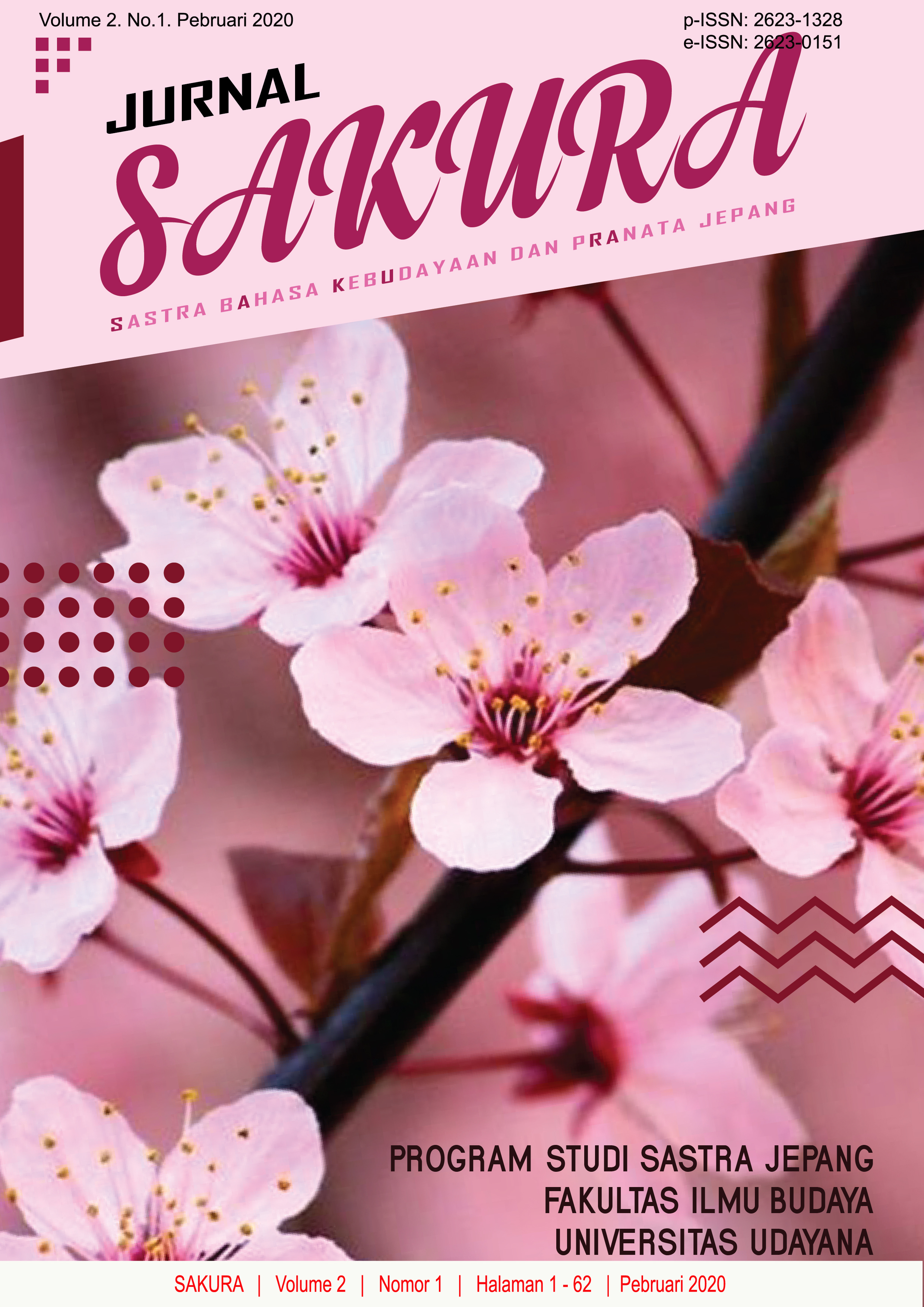Alat-Alat Produksi Masyarakat Ainu dalam Manga Golden Kamuy Karya Satoru Noda
Abstract
This study aims to determine production tools from technological systems of Ainu community in Satoru Noda’s Golden Kamuy manga. The theory used in this research are the theory of anthropological literature by Endraswara (2013), theory of universal cultural elements by Koentjaraningrat (2015) and the semiotics theory by Peirce (1955). The literature study method used as data collection method. The founded data analysed by adjusting the existing of the concepts and theoretical framework. The results of the analysed data presented using descriptive analysis method. The results of analysed data summarized in conclusion with informal method. The obtained result of this research are 4 production tools from technological systems of Ainu community that are represented in the Golden Kamuy manga, such as itata-ni, attush-karabe, isete-ni, and rauomap which is have a role in facilitating the life of Ainu community in obtaining and processing natural product for daily needs.
Downloads
References
Buchler, Justus. 1955. Philosophical Writing of Peirce. New York: Dover Publications, Inc.
Bukh, Alexander. 2016. Ainu Identity and Japan’s Identity: The Struggle for Subjectivity. The Copenhagen Journal of Asian Study Vol. 2, 10.22439/cjas.v28i2.3428.
Cotterill, Simon. 2011. Ainu Success: The Political and Cultural Achievements of Japan’s Indigenous Minority. The Asia-Pasific Journal Vol. 99, No. 2, 3500.
Cheung, Sidney C. H, 2005. Rethinking Ainu Heritage: A Case Study of an Ainu Settlement in Hokkaido, Japan. International Journal of Heritage Studies Vol. 11, No. 14, https://doi.org/10.1080/13527250500160500
Crawford, Gary. W dan Masakazu Yoshizaki. 1987. Ainu Ancestors and Prehistoric Asian Agriculture. Journal of Archaeological Science Vol 14, No. 19, https://doi.org/10.1016/0305-4403(87)90007-0
Dublin, Devon dan Noriyaki Tanaka. 2015. A Comparison Between Satoyama and The Ainu Way of Life. Kawistara Vol. 5, No. 3, pp. 221-328
Endraswara, Suwardi. 2013. Metodologi Penelitian Antropologi Sastra. Yogyakarta: Penerbit Ombak.
Hamada, Shingo. 2016. Ainu Geographic Names and an Indigenous History of the Herring in Hokkaido. The Canadian journal of Native Studies Vol. 35, No. 2, pp. 43-58
Ishii, S., Tamashiro, M. Shibata, dan C. Iwano, H. 2008. Research on The Utility of The Ainu Race Traditional Food Sikerepe. Journal of Rakuno Gakuen University. Natural Science (Japan) Vol. 32, ISSN 0388-001X, pp. 134-144
Jinam, T., Kanzawa-Kiriyama, H., Inoue, I. 2015. Unique characteristics of the Ainu population in Northern Japan. Journal of Human Genetic Vol. 60, No. 10, pp. 565–571, 10.1038/jhg.2015.79
Koentjaraningrat. 2015. Pengantar Ilmu Antropologi. Jakarta: PT. Rineka Cipta.
Kayano, Shigeru. 2000. Ainu Seikatsu Bunka Saigen Manyuaru: Oru “Juhi Koromo”. Sapporo: Ainu Bunka Shinkou dan Kenkyuu Suishin Kikou.
Masuda, Tatsuyoshi. 2013. Rethinking the Ainu Identity and Entrepreneurship: a Statistical Study. International Journal of Business and Globalisation (IJBG), Vol. 11, No. 3 10.1504/IJBG.2013.056201
Nakamura, Naohiro. 2014. Realising Ainu indigenous rights: a commentary on Hiroshi Maruyama's ‘Japan's post-war Ainu policy. Why the Japanese Government has not recognised Ainu indigenous rights?’. Polar Record Vol. 50, No. 2, https://doi.org/10.1017/S0032247413000417
Okada, Mitsuharu Vincent. 2012. The Plight of Ainu, Indigenous People of Japan. Journal Indigenous Social Development Vol. 1, No. 1 E-ISSN 2164-9170.
Sari, Ida Ayu Laksmita. 2019. “Teks dan Praktik: Ritual Iomante pada Cerita Rakyat Ainu Jepang”. Mudra. Jurnal Seni Budaya Vol. 34, No. 2, E-ISSN 2541-0471
Steno, Oda. 2006. Ainu Seikatsu Bunka Saigen Manyuaru: Amu “Goza”. Sapporo: Ainu Bunka Shinkou dan Kenkyuu Suishin Kikou..
Tezuka, Kaoru. 2004. New Evidence for Expansion of the Jomon Culture and the Ainu into the Kuril lslands: from IKIP 2000 Anthropological Research in the Kuril lslands. Bulletin of the Hokkaido University Museum Vol. 2, ISSN 1348-169X
Tierney, Emiko Ohnuki. 1980. Ainu Illness and Healing: A Symbolic Interpretation. Journal of The Amerika Ethnologycal Society Vol. 7, No. 1, https://doi.org/10.1525/ae.1980.7.1.02a00080
Tsunemoto, Teruki. 2019. “Overview of the Ainu Policy Promotion Act of 2019”. Sapporo: Hokkaido University
Tylor, Edward Burnett. 1920. Primitive Culture: Researches into The Development of Mythology, Philosophy, Religion Language, Art, and Custom. London: Murray
Wedayanti, Ni P. L. 2014. "Fungsi Yama Kotoba Dalam Novel Kaiko No Mori." Linguistika: Buletin Ilmiah Program Magister Linguistik Universitas Udayana, vol. 21, No. 2, ISSN 2656-6













